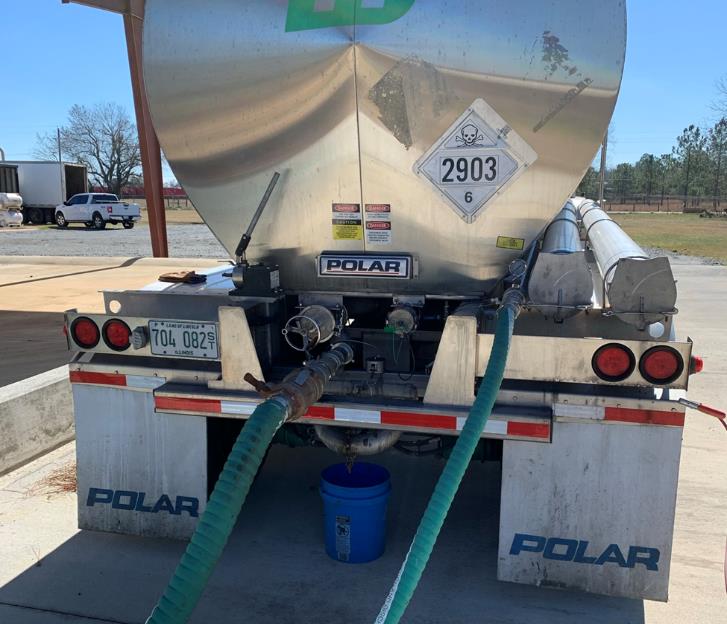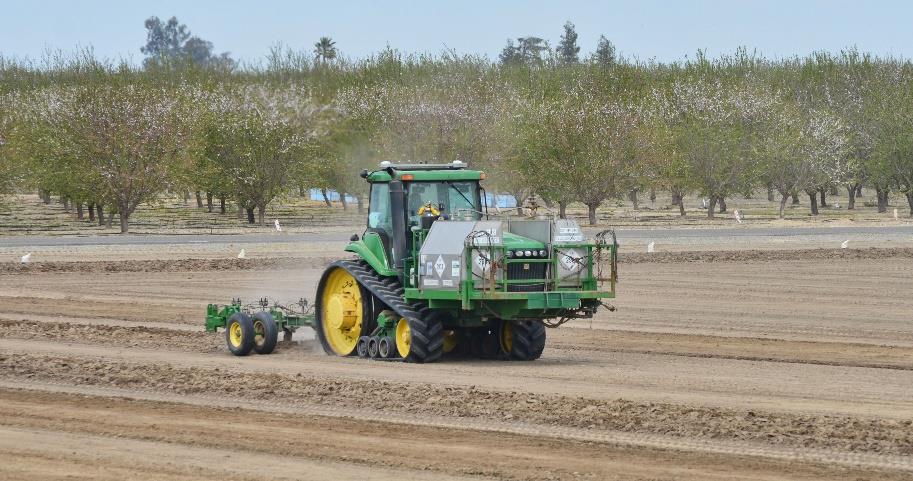This blog post is all about how to safely load and unload a truck delivery of TELONE™. TELONE™, a vital soil fumigant for effective nematode management, requires precise handling during unloading and loading operations. Below, we provide detailed technical instructions to ensure safe and efficient handling of TELONE™ tank trucks. By focusing on specific procedures and safety protocols, these tips aim to minimize risks and maximize operational efficiency. Whether you’re an experienced professional or just starting, these tips will equip you to “Handle Like a Pro.”
These procedures are for reference. Your facility should create a site-specific procedure given your unique equipment configurations and BMP’s.
GENERAL SAFETY BEFORE LOADING OR UNLOADING TELONE™:
- Familiarize yourself with the SDS and product label to help understand the possible hazards and precautions to mitigate those hazards.
- Be sure all handlers are properly trained to load or unload hazardous materials. Never leave loading/unloading operations unattended.
- Ensure all safety equipment is functioning, including: fire extinguisher, safety shower, and eye wash station.
- Verify emergency spill kit is stocked and accessible.
- Inspect PPE appropriate for LIQUID CONTACT POTENTIAL.

UNLOADING TELONE™ TANK TRUCKS INTO BULK TANKS:
- Spot the truck on the loading/unloading containment pad. Chock wheels and set brakes. Secure ignition key, or place a placard in the windshield with the notice: DO NOT MOVE TRUCK DURING UNLOADING. Post signs that state NO SMOKING WITHIN 50 FEET along with required traffic barricades.
- Visually inspect the tanker for any other hazards or potential leaks that may have occurred during transport.
- Connect grounding and bonding cables.
- Verify the contents (material and quantity) by bill of lading. Verify bulk tank has the current label with the EPA Establishment Number corresponding to the location where the product was produced. If not, attach the Teleos Ag Solutions’ supplied bulk tank labels.
- Inspect for intact seals and record seal numbers. Check and record the receiving tank contents and initial level. With bill of lading, verify the tank will contain contents of full tanker without overflow and the tanker unloading line is dedicated and in good condition.
- Verify that the unloading line is labeled and goes to the proper tank. High-liquid level detection should be interlocked to avoid overfilling tanks.
- Inspect the tanker, and check flanges, piping, and valves for tight seal. Examine the dry-disconnect fittings for good condition and good gaskets.
- Don appropriate PPE per product label for liquid-contact potential.
- If a vapor return line is used, connect it to the truck. Open valves in the vapor line between the truck and bulk tank. Follow carrier procedures if the tanker supplies its nitrogen. Connect the liquid transfer hose between the truck and the pump suction connection. Open the proper valves on the truck and tank to transfer.
- Prime and start the pump. Double-check the lines, truck, and tank for leaks and proper alignment. During transfer, verify that the bulk tank level is increasing and the vent is functioning.
- When transfer is complete, elevate the hose and “walk” it toward the pump suction. Pump the hose dry. Close the liquid line valves, starting from the truck toward the bulk tank. Shut down the transfer pump.
- Disconnect the transfer hose from the truck. Close vapor line valves and disconnect the vapor line.
- Check that the volume increase in the bulk tank is equal to the billed truck contents.
- Ensure that transfer lines are not hydrostatically filled with product.
- Cap or plug all connections on the bulk tank, hose, and truck. Stow the transfer hose.
- Remove wheel chocks, ground cable, signs, and barricades. Return ignition key or remove windshield placard and release truck for departure.

LOADING TELONE™ TANK TRUCKS FROM BULK TANKS:
- The driver and at least one qualified employee of the facility shall be present and attentive to the operation as long as the truck is connected to the system.
- The truck must have a “safety package” as indicated in this Guide, and ensure vehicle has proper UN2903 placarding and labeling to meet DOT standards.
- Ensure the tanker is completely dry unless previous product residue remains. Wash water is prohibited. Inspect the pumps, hoses, and other fittings on the truck. Hoses must have dry-disconnect couplings.
- Spot the truck on the loading/unloading containment pad. Chock wheels and set brakes. Secure ignition key, or place a placard in the windshield with the notice: DO NOT MOVE TRUCK DURING LOADING.
- Check the area for and remove ignition hazards. Post the area against ignition hazards: NO SMOKING WITHIN 50 FEET.
- Connect the ground or bonding cable. Also, bond portable tanks to the truck chassis.
- Wear PPE as required by the product label for liquid contact potential
- Check operation of gauges and overfill protection, if applicable, on the truck and bulk storage tank. Note the bulk tank and truck product levels. Calculate levels to be reached when loading is finished.
- Inspect the truck: check flanges, piping, and valves for tight seal. Examine the dry disconnects for good condition and gaskets. Visually check the truck for any other hazards.
- Remove plugs or caps from load connections on the truck. Residue from a previous load may be trapped behind plugs or caps.
- Connect the liquid line from the pump to the loading connection. Connect the vent to a line leading down and away from work areas, or if the receiving vehicle is nitrogen-padded, establish vapor exchange with the bulk tank. Open vent line connections.
- Set the meter, if used, for the delivery quantity. Align the valves on the truck and the bulk site for delivery.
- Start the pump. Watch for leaks. Start delivery of product by activating the truck’s internal valve or meter mechanism. If leaks are detected, shut down the operation for repair.
- Give constant attention to the truck level. Do not overfill the truck.
- When filling is complete, shut off the flow at the dry-disconnect, or at the meter, before shutting off the pump. Close the truck tank valve. NOTE: If draining the hose is desired, a preferred method is nitrogen purging via appropriate valving to push the liquid into the receiving truck or back to the source tank.
- Align the pumping system valves to “off”. Shut off the bulk storage tank valve. Close the vent valve.
- Read and record the gauge readings.
- Disconnect hoses and plug or cap all openings.
- Disconnect the grounding or bonding wire.
If you are interested in learning more about proper guidelines for receiving a bulk railcar of TELONE™, check out our blog post on that topic, here.
If you would like to download a version of this Truck Release Checklist in PDF form, click here.
To see all available Tip Sheets, visit our Stewardship Page.
Remember, product stewardship is all of our responsibility, so thank you for taking the time to read and understand these guidelines. Remember, there’s no coming back from a poor start!
Disclaimer:
The resources and information provided are meant purely for educational discussion, contains only general information about legal matters, and is not to be construed as advice. Please note that any information or resources provided are not legal or regulatory advice, and should not be treated as such. You must not rely on the information provided as an alternative to legal advice from your attorney or other professional services. Teleos Ag encourages readers to consult with counsel, and their local, county, and state regulators. We make no representations or warranties, express or implied, in relation to the information provided through our resources and blog posts. It is the readers responsibility to know the laws related to 1,3- D, appropriate PPE, Licensing, etc., in his or her City, County, State, and Country.
- EQUIPMENT COMPATIBILITY: METAL SELECTION FOR TELONE™ by TELEOS SOIL FUMIGANT - December 16, 2025
- STORAGE SECURITY FOR TELONE™ by TELEOS - October 16, 2025
- TIP SHEET: PLACARDING FOR BULK SHIPMENT RETURNS - August 15, 2025

